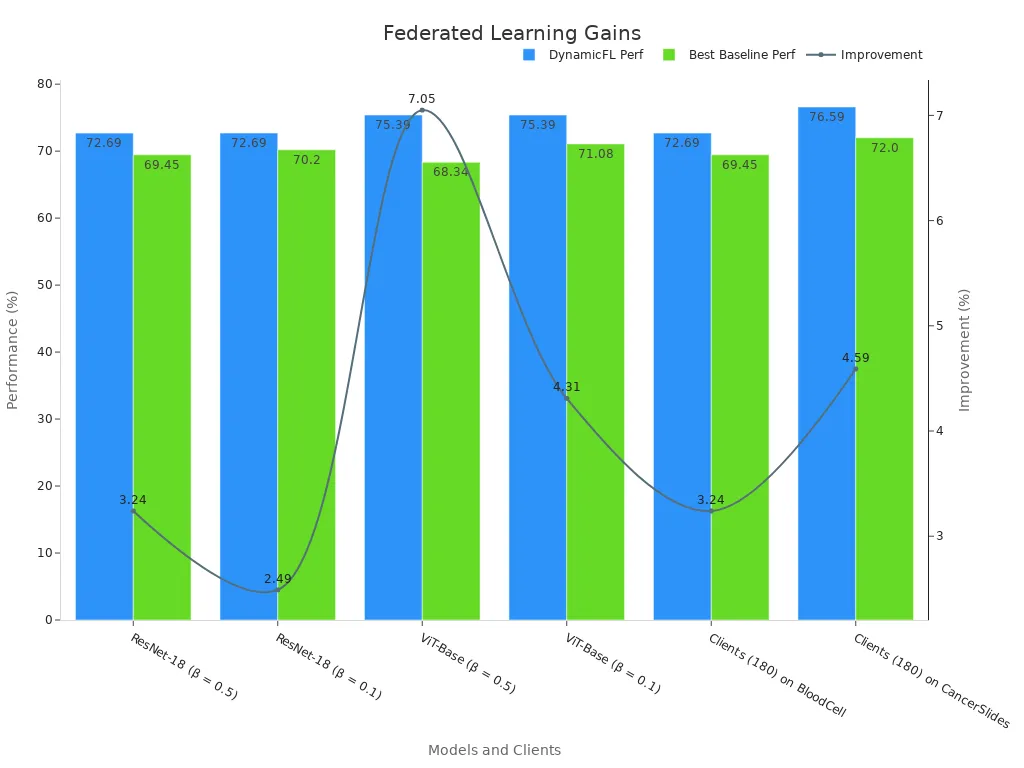
AI federated learning empowers industries to transform how they use data. By decentralizing AI collaboration, it enables organizations to train models without sharing sensitive information. This approach prioritizes data privacy, fostering trust and innovation.
The impact is evident across sectors. Healthcare uses federated learning to improve drug discovery and personalized treatments. Automotive companies enhance autonomous driving technologies through decentralized data. Smart cities rely on it for real-time decision-making, while telecommunications optimize network operations and customer experiences. The global federated learning market, valued at $150 million in 2023, is forecasted to reach $2.3 billion by 2032, growing at a remarkable CAGR of 35.4%. This growth underscores its transformative potential.
Key Takeaways
-
AI federated learning keeps private data on local devices. This helps lower the chance of data being stolen.
-
It lets companies work together on AI models without sharing raw data. This builds trust and sparks new ideas in many fields.
-
Federated learning works well with many devices training models at once. It stays accurate and efficient while doing so.
-
It is used in healthcare, finance, and retail to improve results. For example, it helps with better health checks and catching fraud.
-
New ideas like using blockchain and edge AI will make federated learning even better and more popular in the future.
What is AI Federated Learning?
Definition and Core Principles of Federated Learning
AI federated learning is a groundbreaking approach to machine learning that prioritizes privacy and decentralization. Instead of pooling raw data into a central repository, federated learning enables devices or organizations to collaboratively train a global model by sharing only model parameters. This ensures that sensitive data remains local, reducing privacy risks and complying with regulations like GDPR.
The core principles of federated learning include:
-
Cooperative Learning: Devices or organizations exchange and aggregate model updates rather than raw data.
-
Privacy Preservation: Techniques like differential privacy and secure multi-party computation prevent reverse engineering of individual contributions.
-
Decentralized Architecture: Local devices perform training, while a central server coordinates and aggregates updates securely.
For example, the FL4E Framework demonstrates how federated learning can balance centralization and federation, creating a customizable ecosystem for collaborative research. This adaptability makes it a powerful tool for industries handling sensitive data.
|
Definition/Principle |
الوصف |
|---|---|
|
Cooperative Learning |
Federated learning exchanges model parameters instead of raw data. |
|
Privacy Preservation |
Techniques like differential privacy ensure data security. |
|
Architecture Components |
Combines local training, central coordination, and secure aggregation. |
How Federated Learning Differs from Traditional Machine Learning
Federated learning stands apart from traditional machine learning in several key ways. Traditional methods require centralized data storage, which raises privacy concerns and increases the risk of data breaches. Federated learning, on the other hand, keeps data localized, enabling decentralized training.
|
Aspect |
Federated Learning |
Traditional Machine Learning |
|---|---|---|
|
Data Handling |
Keeps data on local devices, enhancing privacy |
Centralizes data for training |
|
Training Process |
Enables decentralized training |
Requires centralized data storage |
|
Performance |
Can match traditional ML with careful data handling |
Often demands high computational power |
|
Resource Utilization |
Distributes workload across edge devices |
Centralized servers handle the workload |
Research studies highlight these differences. For instance:
-
إن FL-PedBrain platform improved segmentation task performance by 20–30% compared to siloed learning.
-
إن MELLODDY project in the pharmaceutical industry showed that federated models outperformed standalone models in drug discovery.
-
An international study on pediatric brain tumors demonstrated that federated learning performs comparably to traditional methods while preserving privacy.
These findings underscore the potential of federated learning to deliver comparable or superior results without compromising data security.
Key Benefits: Privacy Preservation, Decentralized Collaboration, and Scalability
Federated learning offers several transformative benefits:
-
Privacy Preservation: By keeping data on local devices, federated learning minimizes privacy risks. Techniques like federated adaptive aggregation ensure that raw data never leaves its source. This approach complies with stringent privacy regulations and addresses concerns about data misuse.
-
Decentralized Collaboration: Federated learning enables organizations to collaborate on AI models without sharing sensitive data. For example, financial institutions can jointly develop fraud detection systems while maintaining customer confidentiality. Similarly, healthcare organizations can use federated learning to improve diagnostic accuracy without violating patient privacy.
-
Scalability: Federated learning scales effectively across multiple devices or organizations. Simulations show that increasing the number of clients from 10 to 20 results in only a marginal accuracy drop of 1.5–3%. Even with 50 or 100 clients, accuracy degradation remains moderate, though communication overhead increases.
These benefits make federated learning a versatile solution for industries that require secure, large-scale AI collaboration.
Tip: Federated learning not only enhances privacy but also fosters innovation by enabling organizations to leverage collective intelligence without compromising data security.
Applications of Federated Learning Across Industries

Healthcare
Enhancing medical research through collaborative AI without sharing patient data
Federated learning is revolutionizing healthcare by enabling institutions to collaborate on AI models without compromising patient privacy. This approach allows hospitals, research centers, and pharmaceutical companies to pool their expertise while keeping sensitive data localized. For example, during the COVID-19 pandemic, federated learning facilitated the development of predictive models for disease spread and vaccine efficacy without requiring centralized data storage. This method not only ensures compliance with data protection laws but also fosters trust among patients and healthcare professionals.
Use cases: disease prediction, personalized medicine, and drug discovery
Federated learning supports diverse healthcare applications. It enhances disease prediction by analyzing patterns across multiple datasets, leading to earlier and more accurate diagnoses. In personalized medicine, it enables the creation of tailored treatment plans by combining insights from various institutions. Drug discovery also benefits, as federated learning accelerates the identification of potential compounds by leveraging data from global research efforts. These advancements contribute to better patient outcomes and improved healthcare analytics.
Example: Hospitals collaborating on AI models for early cancer detection
Hospitals worldwide are using federated learning to develop AI models for early cancer detection. By training algorithms on diverse datasets, these models can identify subtle patterns that might otherwise go unnoticed. This collaborative effort improves diagnostic accuracy and ensures that patients receive timely and effective treatment. For instance, federated learning has been instrumental in creating models that detect lung cancer at its earliest stages, significantly increasing survival rates.
Finance
Improving fraud detection and risk management while maintaining customer data privacy
In finance, federated learning enhances fraud prevention and risk management by enabling institutions to share insights without exposing sensitive customer data. This decentralized approach allows banks and financial organizations to collaborate on AI models that detect fraudulent activities and assess risks more effectively. By keeping data localized, federated learning ensures compliance with privacy regulations and builds customer trust.
Use cases: credit scoring, anti-money laundering, and secure financial forecasting
Federated learning powers several critical applications in finance. It improves credit scoring by analyzing data from multiple sources, providing a more comprehensive assessment of an individual's creditworthiness. Anti-money laundering efforts benefit from federated learning's ability to identify suspicious transactions across institutions. Additionally, secure financial forecasting becomes more accurate as federated models incorporate diverse datasets while maintaining data privacy.
Example: Banks sharing insights to combat fraud without exposing sensitive customer information
A practical example of federated learning in finance is its use in fraud detection. Banks collaborate on AI models that analyze transaction patterns to identify fraudulent activities. This approach allows institutions to share valuable insights without revealing customer information. For instance, a consortium of banks used federated learning to reduce fraud rates by 25%, demonstrating its effectiveness in enhancing security while preserving privacy.
Retail
Optimizing customer experiences through personalized recommendations and demand forecasting
Retailers are leveraging federated learning to deliver personalized shopping experiences and improve operational efficiency. By analyzing customer behavior across multiple platforms, federated learning enables the creation of tailored recommendations without compromising data privacy. This approach aligns with the growing demand for personalized AI models in retail, making it a valuable tool for enhancing customer satisfaction.
Use cases: inventory management, targeted marketing, and customer behavior analysis
Federated learning supports various retail applications. It optimizes inventory management by predicting demand trends, ensuring that products are available when and where customers need them. Targeted marketing campaigns become more effective as federated models analyze customer preferences without centralizing data. Additionally, customer behavior analysis provides insights that help retailers refine their strategies and improve overall performance.
Example: Retailers collaborating on AI models to predict shopping trends
Retailers are using federated learning to predict shopping trends and adapt to changing consumer preferences. By collaborating on AI models, they can identify emerging trends and adjust their inventory and marketing strategies accordingly. For example, a group of e-commerce platforms used federated learning to improve demand forecasting accuracy by 15%, resulting in reduced stockouts and increased customer satisfaction.
Technology
Advancing AI development in edge computing and IoT devices
Federated learning is driving innovation in edge computing and IoT devices by enabling decentralized AI training. You can see its impact in applications where data privacy and real-time decision-making are critical. Instead of sending sensitive data to centralized servers, federated learning processes it locally, ensuring compliance with regulations like GDPR and HIPAA. This approach reduces latency, increases efficiency, and lowers costs by minimizing the need for large-scale data transmission and cloud storage.
|
Benefit |
الوصف |
|---|---|
|
Sensitive data is processed locally, minimizing data breaches and ensuring compliance with regulations like GDPR and HIPAA. |
|
|
Real-Time Decision Making |
Enables immediate processing of data on-site, crucial for applications requiring quick responses, enhanced by collective intelligence from federated learning. |
|
Reduced Latency and Increased Efficiency |
Local data processing reduces latency and conserves network bandwidth, essential for applications in industrial automation and emergency services. |
|
Cost Reduction |
Decreases the need for centralized data centers and large-scale data transmission, optimizing network usage and reducing cloud storage costs. |
These benefits make federated learning a cornerstone for advancing AI in edge computing and IoT devices. For example, smart cities use federated learning to optimize traffic flow and energy consumption, ensuring seamless operations while protecting citizen data.
Use cases: smart devices, autonomous vehicles, and cybersecurity
Federated learning enhances AI applications in smart devices, autonomous vehicles, and cybersecurity. Smart devices like voice assistants and smart thermostats use federated learning to improve functionality without compromising user data. Autonomous vehicles benefit from real-time updates on road conditions, enabling safer and more efficient navigation. In cybersecurity, federated learning strengthens defenses by training models on decentralized data, making it harder for attackers to exploit vulnerabilities.
Example: Federated learning powering AI in smart home devices while keeping user data local
Imagine your smart home devices learning from your preferences without exposing your data. Federated learning makes this possible. Devices like smart speakers and security cameras use local data to improve their AI models. This ensures your privacy while delivering personalized experiences. For instance, federated learning allows smart thermostats to optimize energy usage based on individual habits, reducing costs and environmental impact.
Other Industries
Advertising: Personalizing ad targeting while ensuring user data privacy
Federated learning transforms advertising by enabling personalized ad targeting without compromising privacy. You can see this in platforms that analyze user behavior locally to deliver relevant ads. This approach builds trust by ensuring sensitive data never leaves the device. Advertisers benefit from improved targeting accuracy while users enjoy a privacy-first experience.
IoT: Enabling devices to collaboratively learn from real-time data without centralizing raw data
IoT devices rely on federated learning to process real-time data collaboratively. This enhances performance in applications like smart cities and industrial automation. For example, IoT sensors in factories use federated learning to monitor equipment and predict maintenance needs, reducing downtime and costs.
Robotics: Enhancing AI models for real-time task performance across multiple devices
Robotics applications thrive on federated learning. Robots in warehouses or hospitals use decentralized AI models to improve task performance. By sharing insights without centralizing data, federated learning ensures faster adaptation to changing environments. This makes robots more efficient and reliable in critical operations.
Manufacturing: Predictive maintenance through analysis of equipment performance data
Manufacturing benefits from federated learning through predictive maintenance. You can see this in factories where equipment performance data is analyzed locally to identify potential failures. This reduces downtime and extends the lifespan of machinery, saving costs and improving productivity.
Autonomous Vehicles: Improving safety and efficiency by training models on data from multiple vehicles
Federated learning enhances autonomous vehicles by enabling them to learn from data collected by other vehicles. This improves decision-making and safety. For example, vehicles share insights on traffic patterns and road conditions, allowing them to navigate more effectively. This collaborative approach reduces training time and increases prediction accuracy, making autonomous driving safer and more reliable.
Tip: Federated learning ensures privacy protection across industries, making it a versatile solution for applications requiring decentralized AI collaboration.
Benefits and Limitations of Federated Learning
Benefits
Enhanced data privacy and security
Federated learning prioritizes data privacy by ensuring that sensitive information remains on local devices. This approach minimizes the risk of data breaches and complies with privacy regulations like GDPR and HIPAA. For example, DynamicFL enhances privacy by separating model gradients from private data, reducing the risk of gradient inversion attacks. This design ensures that even if malicious entities attempt to reconstruct data, they face significant barriers. In healthcare, privacy regulations demand such robust measures to protect patient data while enabling collaborative research.
Improved collaboration across organizations and geographies
Federated learning fosters collaboration by allowing organizations to train AI models collectively without sharing raw data. This capability is particularly valuable in industries like finance and healthcare, where privacy regulations restrict data sharing. For instance, banks can collaborate on fraud detection models while maintaining customer confidentiality. Studies show that federated approaches like FedAvg perform comparably to newer algorithms, proving their effectiveness in large-scale collaborations.
Scalability for large-scale AI applications
Federated learning scales efficiently across numerous devices and organizations. Research demonstrates that increasing the number of clients from 60 to 180 improves model accuracy by up to 4%. This scalability makes federated learning ideal for applications like autonomous vehicles and IoT devices, where data is distributed across vast networks. The ability to aggregate insights from diverse datasets ensures better outcomes without compromising user data privacy.

Limitations
Challenges in model synchronization and communication overhead
Federated learning faces challenges in synchronizing models across multiple devices. Communication overhead increases as the number of clients grows, potentially slowing down training processes. Studies reveal that while larger distributions may initially reduce accuracy, sufficient training rounds can mitigate this issue. Proper client sampling and optimized communication protocols are essential to address these challenges.
Need for robust infrastructure and standardization
Implementing federated learning requires a robust infrastructure. Organizations must invest in edge devices, secure communication channels, and standardized protocols. Without these, federated systems may struggle to maintain efficiency. For example, hyperparameters like batch size and learning rates significantly impact outcomes, requiring careful tuning to ensure optimal performance.
Addressing biases in decentralized data
Decentralized data often exhibits non-IID (non-independent and identically distributed) characteristics, leading to biases in model training. Skewed data volumes can affect accuracy, particularly in sensitive applications like healthcare. Federated learning must adopt strategies like weighted aggregation to balance contributions from diverse datasets. This approach ensures fairness in predictive outcomes while maintaining compliance with privacy regulations.
|
Aspect |
Benefit/Limitations |
|---|---|
|
Data Distribution |
Non-IID data distribution significantly impacts model accuracy, with skewed data volumes having limited effects. |
|
Client Sampling |
Proper client sampling can enhance model accuracy without compromising efficiency. |
|
Scale of FL |
Larger distribution may initially reduce accuracy, but models can catch up with sufficient training rounds. |
|
Local Learning Strategies |
Hyperparameters like batch size affect learning, but their impact varies in FL compared to centralized learning. |
|
Global Federation Approaches |
FedAvg performs comparably to newer algorithms like FedAdam and FedYogi, indicating its effectiveness. |
Note: While federated learning offers transformative benefits, addressing its limitations requires continuous innovation and investment in infrastructure.
The Future of Federated Learning

Predictions for Federated Learning Adoption in the Next Decade
The adoption of federated learning is set to grow rapidly over the next ten years. You will see this technology becoming a standard in industries like healthcare and finance, where privacy and compliance with regulations are critical. The increasing demand for secure AI solutions will drive its integration into business applications, especially in software development.
Several factors contribute to this growth:
-
إن global federated learning market is expanding as organizations seek better ways to collaborate without compromising data privacy.
-
Predictive methods that protect personal information are becoming essential in regulated sectors.
-
Federated learning's scalability makes it accessible to businesses of all sizes, reducing infrastructure costs while enabling advanced analytics.
This trajectory highlights how federated learning will reshape industries by balancing innovation with privacy protection.
Emerging Trends: Integration with Blockchain, Advancements in Edge AI, and Regulatory Support
Emerging trends are shaping the future of federated learning. Blockchain integration is one of the most promising developments. By combining blockchain with federated learning, you can enhance data security and ensure the integrity of decentralized systems. Blockchain also enables decentralized identities, improving privacy in applications like supply chain management.
Edge AI is another transformative trend. It processes data closer to its source, reducing latency and enhancing privacy. This makes federated learning ideal for real-time applications like autonomous vehicles and IoT devices. Studies show that decentralized machine-learning models are gaining popularity for addressing privacy concerns in AI training.
Regulatory support is also accelerating adoption. Governments and organizations are introducing frameworks to promote privacy-preserving AI. These regulations encourage the use of federated learning in sectors where data confidentiality is paramount. Together, these trends are driving innovation while ensuring compliance with evolving privacy standards.
The Role of Federated Learning in Shaping a Privacy-First AI Ecosystem
Federated learning is central to creating a privacy-first AI ecosystem. By keeping sensitive data local, it allows you to train collaborative models without exposing personal information. This approach aligns with growing consumer awareness and stricter data regulations.
على سبيل المثال, hospitals use federated learning to train diagnostic models without sharing patient records. Similarly, banks improve fraud detection by analyzing transaction patterns without exposing customer data. These applications demonstrate how federated learning enhances privacy while enabling innovation.
As privacy concerns continue to rise, federated learning will play a pivotal role in ensuring ethical AI development. Its ability to process data securely and comply with regulations makes it a cornerstone of the future AI landscape. You can expect this technology to redefine how industries approach data privacy and collaboration.
AI federated learning is reshaping industries by enabling secure and collaborative AI innovation. Its applications in healthcare, finance, retail, and technology solve critical challenges while preserving privacy. For example, federated learning enhances electronic health record (EHR) standardization, improves model performance with limited data, and ensures security through advanced protocols.
|
Evidence Type |
الوصف |
|---|---|
|
Federated learning improves data sharing and analysis, enhancing interoperability. |
|
|
Model Performance |
Federated models outperform localized ones, especially with limited data. |
|
Privacy and Security |
Maintains privacy by keeping data local and using advanced security protocols. |
Reports like Capgemini's “Data Sharing Masters” highlight the economic potential of federated learning, predicting that data ecosystems could generate 2-9% of annual revenue for large organizations over five years. Emerging trends such as personalized federated learning and blockchain integration further indicate its strong future in driving AI innovation.
As federated learning evolves, it will continue to balance innovation with privacy, making it a cornerstone of the AI landscape. You are encouraged to explore its applications and discover how it can transform your industry.
التعليمات
What makes federated learning different from traditional AI training methods?
Federated learning trains AI models without centralizing data. It keeps sensitive information on local devices, ensuring privacy. Traditional methods require data to be stored in one location, increasing the risk of breaches. Federated learning also enables collaboration across organizations while maintaining data security.
How does federated learning ensure data privacy?
Federated learning uses techniques like differential privacy and secure aggregation. These methods prevent raw data from being shared or reconstructed. Only model updates, not the actual data, are exchanged. This ensures that your sensitive information stays secure and private.
Can small businesses benefit from federated learning?
Yes! Federated learning scales to businesses of all sizes. Small businesses can collaborate on AI models without needing large datasets. This allows them to access advanced AI capabilities while keeping their customer data private and secure.
What industries are adopting federated learning the fastest?
Healthcare, finance, and technology are leading adopters. Healthcare uses it for medical research and diagnostics. Finance applies it to fraud detection and risk management. Technology integrates it into IoT devices and edge computing for real-time decision-making.
Is federated learning expensive to implement?
Federated learning requires investment in infrastructure like edge devices and secure communication channels. However, it reduces costs associated with centralized data storage and compliance with privacy regulations. Over time, it becomes cost-effective, especially for industries handling sensitive data.
Tip: Start small with federated learning by focusing on specific use cases. Gradually scale as you see results.








